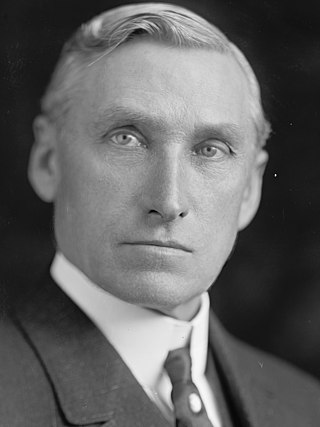Related Research Articles

Richard Elihu Sloan was an American jurist and politician, who served as associate justice of the Arizona Territorial Supreme Court, a United States district judge of the United States District Court for the District of Arizona and as the 17th and final Governor of Arizona Territory. As an Associate Justice he served for 16 years, the longest service of any member of the Arizona Territorial Supreme Court, and wrote over 150 legal opinions. As Governor he oversaw Arizona's transition from territory to statehood.
The 13th Arizona Territorial Legislative Assembly was a session of the Arizona Territorial Legislature which began on January 12, 1885, in Prescott, Arizona. The session's accomplishments included allocation of a variety of territorial institutions including a university, normal school, prison, and insane asylum. Nicknames bestowed to the session include the "bloody thirteenth" due to fights in the halls of government and nearby saloons, and the "thieving thirteenth" due to the very large appropriations approved by this legislature.
The 2nd Arizona Territorial Legislative Assembly was a session of the Arizona Territorial Legislature which began on December 6, 1865, in Prescott, Arizona, and ran for 24 days. The sessions chief accomplishments were creation of Pah-Ute County and establishing Arizona as a community property jurisdiction.
The 15th Arizona Territorial Legislative Assembly was a session of the Arizona Territorial Legislature which began on January 21, 1889, in Prescott, Arizona, moved to Phoenix on February 7 and did not adjourn till April 11. The session is known as the "Hold-over Legislature" due to the Republican majority extending the length of the session past the sixty-day limit prescribed by law.
The 5th Arizona Territorial Legislative Assembly was a session of the Arizona Territorial Legislature which met from November 10, 1868, to December 16, 1868, in Tucson, Arizona Territory. It was the last of the annual legislative sessions.
The 6th Arizona Territorial Legislative Assembly was a session of the Arizona Territorial Legislature which met in Tucson beginning on January 11, 1871, and ran until February 14, 1871.
The 7th Arizona Territorial Legislative Assembly was a session of the Arizona Territorial Legislature which convened on January 6, 1873, in Tucson, Arizona Territory.
The 9th Arizona Territorial Legislative Assembly was a session of the Arizona Territorial Legislature which convened on January 1, 1877, in Tucson, Arizona Territory. It passed 79 statutes and adopted the Hoyt Code as the basis of the Territory's legal system.
The 8th Arizona Territorial Legislative Assembly was a session of the Arizona Territorial Legislature which convened from January 4, 1875, till February 12, 1875, in Tucson, Arizona Territory.
The 10th Arizona Territorial Legislative Assembly was a session of the Arizona Territorial Legislature which convened on January 6, 1879, in Prescott, Arizona Territory. The session was the last to be composed of nine Council members and eighteen members of the House of Representatives.
William Henry Stilwell was an American jurist who served as Associate Justice of the Arizona Territorial Supreme Court from 1880 till 1882. Following his removal from the bench, he remained in the territory where he was active in Republican politics and became an expert in mining law and water rights.
The 14th Arizona Territorial Legislative Assembly was a session of the Arizona Territorial Legislature which convened in Prescott, Arizona. The session ran from January 10, 1887, till March 10, 1887.
The 18th Arizona Territorial Legislative Assembly was a session of the Arizona Territorial Legislature which met in Phoenix, Arizona. The session ran from January 21 to March 21, 1895. Due to the abrupt manner in which the session ended, none of the usual appropriations bills were passed by the legislature.
The 16th Arizona Territorial Legislative Assembly was a session of the Arizona Territorial Legislature which convened in Phoenix, Arizona. The session began on January 19, 1891.
The 12th Arizona Territorial Legislative Assembly was a session of the Arizona Territorial Legislature which convened on January 8, 1883, in Prescott, Arizona Territory.
The 19th Arizona Territorial Legislative Assembly was a session of the Arizona Territorial Legislature which convened in Phoenix, Arizona. The session began on January 18, 1897, and ended on March 18, 1897.
The 23rd Arizona Territorial Legislative Assembly was a session of the Arizona Territorial Legislature which convened in Phoenix, Arizona, United States. The session ran from January 16, 1905, till March 16, 1905.
The 24th Arizona Territorial Legislative Assembly was a session of the Arizona Territorial Legislature which convened in Phoenix, Arizona. The session ran from January 21, 1907, till March 21, 1907.
The 25th Arizona Territorial Legislative Assembly was the final session of the Arizona Territorial Legislature. The session convened in Phoenix, Arizona, and ran from January 18 till March 18, 1909. Its actions include the creation of Greenlee County, establishing the Arizona Pioneers' Home, and requiring primary elections.
The capital of the Arizona Territory was established in Prescott, but was moved to Tucson, back to Prescott, and finally to Phoenix over 25 years as political power shifted as the territory grew, developed, and stabilized. Each move was controversial.
References
- ↑ McClintock 1916, p. 371.
- ↑ Goff 1978, p. 57.
- ↑ Goff 1978, pp. 78–79.
- ↑ Goff 1978, p. 79.
- 1 2 3 Goff 1978, p. 80.
- 1 2 3 Wagoner 1970, p. 174.
- 1 2 McClintock 1916, p. 333.
- 1 2 3 4 5 6 Wagoner 1970, p. 175.
- ↑ Wagoner 1970, p. 176.
- ↑ Wagoner 1970, p. 173.
- 1 2 Wagoner 1970, p. 515.
- Goff, John S. (1978). Arizona Territorial Officials Volume II: The Governors 1863–1912. Cave Creek, Arizona: Black Mountain Press. OCLC 5100411.
- McClintock, James H. (1916). Arizona, Prehistoric, Aboriginal, Pioneer, Modern Vol. II. Chicago: S. J. Clarke.
- Wagoner, Jay J. (1970). Arizona Territory 1863–1912: A Political history . Tucson: University of Arizona Press. ISBN 0816501769.
